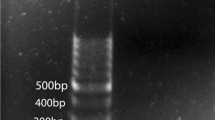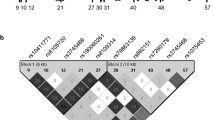Abstract
Thus far only a limited number of studies examined the association between endothelial nitric oxide synthase (eNOS) polymorphisms and proliferative diabetic retinopathy (PDR). In this report, two polymorphisms in the eNOS gene have been investigated, namely the 894G>T (Glu298Asp) and a 27 bp VNTR (4b/4a), to assess their possible relationships to PDR among Slovenian (Caucasians) type 2 diabetic patients. This cross-sectional case–control study enrolled 577 unrelated Slovenian subjects (Caucasians) with type 2 diabetes mellitus. The case group consisted of 172 patients with PDR and the control group had 405 patients who had no clinical signs of diabetic retinopathy (DR) but did have type 2 diabetes for more than 10 years’ duration. Genotyping of eNOS polymorphisms was carried out with conventional and real-time PCR assays. A significantly higher frequency of the eNOS minor “4a” allele was found in patients with PDR than in controls (23.6 versus 17.7%, p = 0.01). Moreover, the univariate analysis showed a significant association of the 27 bp VNTR 4a/4a genotype and PDR in the recessive model. The odds ratio (OR) of PDR for the 4a/4a genotype to 4b/4a plus 4b/4b was 2.9 (95% CI 1.3–6.2, p = 0.005). Further, the presence of 4a/a genotype was associated with a 3.4-fold (95% CI 1.4–8.6, p = 0.009) increased risk for PDR while adjusted for other risk factors. This is the first study to implicate eNOS 4a/4a homozygous deletion, and hence the “4a” allele, as the genetic risk factors for PDR in Caucasians.
Similar content being viewed by others
References
Doganay S, Everklioglu C, Er H et al (2002) Comparison of serum NO, TNF-α, IL-1β, sil-2R, IL-6 and IL-8 levels with grades of retinopathy in patients with diabetes mellitus. Eye 16:163–170
El-Asrar AM, Struyf S, Opdenakker G, Van Damme J, Geboes K (2010) Expression of stem cell factor/c-kit signalling pathway components in diabetic fibrovascular epiretinal membranes. Mol Vis 16:1098–1107
Hallman DM, Huber JC, Gonzalez VH, Klein BE, Klein R, Hanis CL (2005) Familial aggregation of severity of diabetic retinopathy in Mexican Americans from Starr county, Texas. Diabetes Care 28:1163–1168
Rema M, Saravanan G, Deepa R, Mohan V (2002) Familial clustering of diabetic retinopathy in south Indian type 2 diabetic patients. Diabetes Med 19:910–916
Warpeha KM, Charkravarthy U (2003) Molecular genetics of diabetic retinopathy. Eye 17:305–311
Balasubbu S, Rajendran A, Ramasamy K, Namperumalsamy P, Sundaresan P (2006) Emerging patterns of possible potential candidate gene polymorphisms associated with diabetic retinopathy-a. Asian J Exp Sci 20:15–28
Ng DPK (2010) Human genetics of diabetic retinopathy: current perspectives. J Ophthalmol 2010:1–6
Patel S, Chen H, Tinkham NH, Zhankg K (2008) Genetic susceptibility of diabetic retinopathy. Curr Diabetes Rep 8:257–262
McVeigh GE, Brennan GM, Johnston GD et al (1992) Impaired endothelial-dependent and independent vasodilatation in patients with type 2 (non-insulin dependent) diabetes mellitus. Diabetologia 35:771–776
Moncada S, Higgs EA (2006) The discovery of nitric oxide and its role in vascular biology. Br J Pharmacol 147:S193–S201
Yang Y, Hayden MR, Sowers S, Bagree SV, Sowers JR (2010) Retinal redox stress and remodeling in cardiometabolic syndrome and diabetes. Oxid Med Cell Longev 3:392–403
Toda N, Nakanishi-Toda M (2007) Nitric oxide: ocular blood flow, glaucoma, and diabetic retinopathy. Prog Retin Eye Res 26:205–238
Alderton WK, Cooper CE, Knowles RG (2001) Nitric oxide synthases: structure, function and inhibition. Biochem J 357:593–615
Miyamoto Y, Saito Y, Nakayama M et al (2000) Replication protein A1 reduces transcription of the endothelial nitric oxide synthase gene containing a −786T → C mutation associated with coronary spastic angina. Hum Mol Genet 9:2629–2637
Asif AR, Oellerich M, Armstrong VW, Hecker M, Cattaruzza M (2009) T-786C polymorphism of the NOS-3 gene and the endothelial cell response to fluid shear stress-a proteome analysis. J Proteome Res 8:3161–3168
Farbstein D, Levy AP (2010) The genetics of vascular complications in diabetes mellitus. Cardiol Clin 28:477–496
Bank N, Aynedijan HS (1993) Role of EDRF (nitric oxide) in diabetic renal hyperfiltration. Kidney Int 43:1306–1312
Fairchild TA, Fulton D, Fontana JT, Gratton JP, McCabe TJ, Sessa WC (2001) Acidic hydrolysis as a mechanism for the cleavage of the Glu298Asp variant of human endothelial nitric oxide synthase. J Biol Chem 276:26674–26679
Tesauro M, Thompson WC, Rogliani P, Qi L, Chaudhary PP, Moss J (2000) Intracellular processing of endothelial nitric oxide synthase isoforms associated with differences in severity of cardiopulmonary diseases: cleavage of proteins with aspartate vs. glutamate at position 298. Proc Natl Acad Sci USA 97:2832–2835
Pulkkinen A, Viitanen L, Kareinen A, Lehto S, Vauhkonen I, Laakso M (2000) Intron 4 polymorphism of the endothelial nitric oxide synthase gene is associated with elevated blood pressure in type 2 diabetic patients with coronary heart disease. J Mol Med 78:372–379
Casas JP, Bautista LE, Humphries SE, Hingorani AD (2004) Endothelial nitric oxide synthase genotype and ischemic heart disease: meta-analysis of 26 studies involving 23,028 subjects. Circulation 109:1359–1365
Rao S, Austin H, Davidoff MN, Zafari AM (2005) Endothelial nitric oxide synthase intron 4 polymorphism is a marker for coronary artery disease in African–American and Caucasian men. Ethn Dis 15:191–197
Neugebauer S, Baba T, Watanabe T (2000) Association of the nitric oxide synthase gene polymorphism with an increased risk for progression to diabetic nephropathy in type 2 diabetes. Diabetes 49:500–503
Taverna MJ, Sola A, Guyot-Argenton C et al (2002) eNOS4 polymorphism of the endothelial nitric oxide synthase predicts risk for severe diabetic retinopathy. Diabetes Med 19:240–245
Awata T, Neda T, Iizuka H et al (2004) Endothelial nitric oxide synthase gene is associated with diabetic macular edema in type two diabetes. Diabetes Care 27:2184–2190
Chen Y, Huang H, Zhou J et al (2007) Polymorphism of the endothelial nitric oxide synthase gene is associated with diabetic retinopathy in a cohort of west Africans. Mol Vis 13:2142–2147
Ezzidi I, Mtiraoui N, Mohamed MBH, Mahjoub T, Kacem M, Almawi WY (2007) Endothelial nitric oxide synthase Glu298Asp, 4b/a, and T-786C polymorphisms in type 2 diabetic retinopathy. Clin Endocrinol 68:542–546
Frost D, Chitu J, Meyer M, Beischer W, Pfohl M (2003) Endothelial nitric oxide synthase (ecNOS) 4 a/b gene polymorphism and carotid artery intima-media thickness in type-1 diabetic patients. Exp Clin Endocrinol Diabetes 111:12–15
de Syllos RWC, Sandrim VC, Lisboa HRK, Tres GS, Tanus-Santos JE (2006) Endothelial nitric oxide synthase genotype and haplotype are not associated with diabetic retinopathy in diabetes type 2 patients. Nitric Oxide 15:417–422
Suganthalakshmi B, Anand R, Kim R et al (2006) Association of VEGF and eNOS gene polymorphisms in type 2 diabetic retinopathy. Mol Vis 12:336–341
Abhary S, Hewitt AW, Burdon KP, Craig JE (2009) A systemic meta-analysis of genetic association studies for diabetic retinopathy. Diabetes 58:2137–2147
Li H, Louey JWC, Choy KW et al (2008) EDN1 Lys198Asn is associated with diabetic retinopathy in type 2 diabetes. Mol Vis 14:1698–1704
Uthra S, Raman R, Mukesh BN et al (2007) Intron 4 VNTR of endothelial nitric oxide synthase (eNOS) gene and diabetic retinopathy in type 2 patients in southern India. Ophthalmic Genet 28:77–81
The expert committee on the diagnosis and classification of diabetes mellitus (2003). Report of the expert committee on the diagnosis and classification of diabetes mellitus. Diabetes Care 26:S5–S20
Early treatment diabetic retinopathy study research group (1991) Grading diabetic retinopathy from stereoscopic colour fundus photographs—an extension of the modified Airlie house classification ETDRS report number 10. Ophthalmology 98:786–806
Wang XL, Sim AS, Badenhop RF, McCredie RM, Wilcken DE (1996) A smoking-dependent risk of coronary artery disease associated with a polymorphism of the endothelial nitric oxide synthase gene. Nature Med 2:41–45
Elston RC, Forthofer R (1977) Testing for Hardy–Weinberg equilibrium in small samples. Biometrics 33:536–542
Kalinowski ST (2006) Hw-QuickCheck: an easy-to-use computer program for checking genotypes for agreement with Hardy–Weinberg expectations. Mol Ecol Notes 6:974–979
Purcell S, Neale B, Todd-Brown K et al (2007) PLINK: a tool set for whole-genome association and population-based linkage analyses. Am J Hum Genet 81:559–575
Dupont WD, Plummer WD (1997) PS power and sample size program available for free on the Internet. Control Clin Trials 18:274
Ahluwalia TS, Ahuja M, Rai TS et al (2008) Endothelial nitric oxide synthase gene haplotypes and diabetic nephropathy among Asian Indians. Mol Cell Biochem 314:9–17
Asakimori Y, Yorioka N, Yamamoto I et al (2001) Endothelial nitric oxide synthase intron 4 polymorphism influences the progression of renal disease. Nephron 89:219–223
Zanchi A, Moczulski DK, Hanna LS, Wantman M, Warram JH, Krolewski AS (2000) Risk of advanced diabetic nephropathy in type 1 diabetes is associated with endothelial nitric oxide synthase gene polymorphism. Kidney Int 57:405–413
White NH, Sun W, Cleary PA et al (2009) Prolonged effect of intensive therapy on the risk of retinopathy complications in patients with type 1 diabetes mellitus: 10 years after the diabetes control and complications trial. Arch Ophthalmol 126:1707–1715
Nakamura S, Iwasaki N, Funatsu H, Kitano S, Iwamoto Y (2009) Impact of variants in the VEGF gene on progression of proliferative diabetic retinopathy. Graefes Arch Clin Exp Ophthalmol 247:21–26
Stratton IM, Kohner EM, Aldington SJ et al (2001) UKPDS 50: risk factors for incidence and progression of retinopathy in type II diabetes over 6 years from diagnosis. Diabetologia 44:156
Esser C, Tomiuk J (2005) Reporting Hardy–Weinberg tests in case-control studies: reasons for caution but not for panic reactions. J Invest Dermatol 124:1082–1083
Wang J, Dudley D, Wang XL (2002) Haplotype-specific effects on endothelial NO synthase promoter efficiency: modifiable by cigarette smoking. Arterioscler Thromb Vasc Biol 22:e1–e4
Nakayama M, Yasue H, Yoshimura M et al (1999) T-786–>C mutation in the 5′-flanking region of the endothelial nitric oxide synthase gene is associated with coronary spasm. Circulation 99:2864–2870
Acknowledgments
The authors thanked Mrs. Visam Bajt, BA, for revising the English.
Author information
Authors and Affiliations
Corresponding author
Additional information
Ines Cilenšek and Sara Mankoč contributed equally to this work.
Rights and permissions
About this article
Cite this article
Cilenšek, I., Mankoč, S., Petrovič, M.G. et al. The 4a/4a genotype of the VNTR polymorphism for endothelial nitric oxide synthase (eNOS) gene predicts risk for proliferative diabetic retinopathy in Slovenian patients (Caucasians) with type 2 diabetes mellitus. Mol Biol Rep 39, 7061–7067 (2012). https://doi.org/10.1007/s11033-012-1537-8
Received:
Accepted:
Published:
Issue Date:
DOI: https://doi.org/10.1007/s11033-012-1537-8




